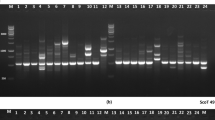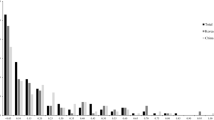Abstract
Rhubarb samples were collected from home gardens all around Finland to study their genetic diversity. Altogether, the study contained 647 samples, of which 539 were from home gardens. In addition, reference cultivars and samples from the Finnish national collection of rhubarb genetic resources located in the Natural Resources Institute Finland (Luke) were included. Six SSRs, which amplified a total of 80 alleles, were used to calculate genetic distances between samples, and a dendrogram was built. The most common cultivar among the rhubarbs from Finnish home gardens (57%) was identical to ‘Queen Victoria’ in the Luke collection. Thirty-eight samples (7%) from citizens were identical to ‘The Sutton’ and ‘Strawberry’, which on the other hand were identical to each other. We detected misidentifications of rhubarb cultivars in our study. Under the same cultivar name there might be different genotypes, for example ‘Victoria’ was very heterogeneous. On the other hand, cultivars with different names may have the same genotype e.g. ‘Strawberry’ and ‘The Sutton’. In addition to providing information about genetic variability of rhubarbs in home gardens, the results of the study were used to update the Finnish national collection of rhubarb genetic resources: to remove duplicates, and to replace accessions of unknown origin with new polymorphic ones with more accurate information of their history. As far as we know, this is the first study where rhubarb samples have been collected widely from home gardens and evaluated with DNA markers.


Similar content being viewed by others
References
Abuzayed M, El-Dabba N, Frary A, Doganlar S (2017) GDdom: an online tool for calculation of dominant marker gene diversity. Biochem Genet 55:155–157
Chin TC, Youngken HW (1947) The cytotaxonomy of Rheum. Am J Bot 34:401–407
Eneroth O (1860) Kasvutarha-kirja rahvaan hyödyksi. GW Wilén, Helsinki
Englund R (1983) Odlad rabarber och taxonomiska problem inom släktet Rheum, speciellt sektionen Rhapontica. Report, Dept. of Systematic Botany, Uppsala University, Sweden (in Swedish)
Foust CM (1992) Rhubarb: the wondrous drug. Princeton University Press, Princeton
Gilmore BS, Bassil NV, Barney DL, Knaus BJ, Hummer KE (2014) Short-read DNA sequencing yields microsatellite markers for Rheum. J Am Soc Hortic Sci 139(1):22–29
Hintze S (1951) Rabarber. In: Svensk växtförädling Del II Trädgårdsväxterna Skogsväxterna. Natur och Kultur, Stockholm, pp 389–391 (in Swedish)
Kuhl JC, DeBoer VL (2008) Genetic diversity of rhubarb cultivars. J Am Soc Hortic Sci 133(4):587–592
Libert B, Englund R (1989) Present distribution and ecology of Rheum rhaponticum (Polygonaceae). Willdenowia Bd 19, H 1:91–98
Lozina-Lozinskaja AS (1936) Sistematiceskij obzor dikorastuscich vidov roda Rheum L. Trudy Bot Inst Akad Nauk SSSR, Ser. 1. Fl Sist Vyss Rast 3:67–141
Pantoja A, Kuhl JC (2009) Morphologic variation in the USDA/ARS rhubarb germplasm collection. Plant Genet Resour-C 8(1):35–41
Perrier X, Jacquemoud-Collet JP (2006). DARwin software. http://darwin.cirad.fr/darwin
Persson HA, Rumpunen K, Möllerstedt LK (2000) Identification of culinary rhubarb (Rheum spp.) cultivars using morphological characterization and RAPD markers. J Hortic Sci Biotechnol 75(6):684–689
Roldan-Ruiz I, Dendauw J, Bockstaele EV, Depicker A, Loose MD (2000) AFLP markers reveal high polymorphic rates in ryegrass (Lolium spp.). Mol Breed 6:125–134
Rumpunen K, Henriksen K (1999) Phytochemical and morphological characterization of seventy-one cultivars and selections of culinary rhubarb (Rheum spp.). J Hortic Sci Biotechnol 74(1):13–18
Ruoff E (2001) Vanhoja suomalaisia puutarhoja. Otavan Kirjapaino Oy, Keuruu
Saitou N, Nei M (1987) The neighbor-joining method: a new method for reconstructing phylogenetic trees. Mol Biol Evol 4:406–425
Stanev S (1984) Rheum rhaponticum. In: Velchev V (ed) Červena kniga na NR Bǎlgarija 1. –Sofija, p 90
Stocks C (2009) Forgotten fruits: the stories behind Britain’s traditional fruit and vegetables. Windmill Books, London
Stojanoff N (1937) Über die Autochtonität des Rila-Rhabarbers. Izv Carsk Prir Inst Sofija 10:247–258
Tanhuanpää P, Manninen O (2012) High SSR diversity but little differentiation between accessions of Nordic timothy (Phleum pratense L.). Hereditas 149(4):114–127
Tinker NA, Fortin MG, Mather DE (1993) Random amplified polymorphic DNA and pedigree relationships in spring barley. Theor Appl Genet 85:976–984
Turner DM (1938) The economic rhubarbs: a historical survey of their cultivation in Britain. J R Hortic Soc 63:355–370
USDA, Agricultural Research Service, National Plant Germplasm System (2018) Germplasm Resources Information Network (GRIN-Taxonomy). National Germplasm Resources Laboratory, Beltsville, Maryland. https://npgsweb.ars-grin.gov/gringlobal/taxonomydetail.aspx?id=31110. Accessed 29 Aug 2018
Walkey DGA, Mathews KAM (1979) Rapid cloning propagation of rhubarb (Rheum rhaponticum) from meristem-tips in tissue culture. Plant Sci Lett 14:301–308
Wang A, Yang M, Liu J (2005) Molecular phylogeny, recent radiation and evolution of gross morphology of the rhubarb genus Rheum (Polygonaceae) inferred from chloroplast DNA trnL-F sequences. Ann Bot 96:489–498
Zandstra BH, Marshall DE (1982) A grower’s guide to rhubarb production. Am Veg Grower 30(6):9–10
Zhang D-Y, Chen N, Yang Y-Z, Zhang Q, Liu J-Q (2008) Development of 10 microsatellite loci for Rheum tanguticum (Polygonaceae). Conserv Genet 9:475–477
Acknowledgements
The authors wish to thank Marja-Riitta Arajärvi, Sirpa Moisander and Anneli Virta for excellent technical assistance. Finnish citizens and nurseries, as well as Morten Rasmussen (Norwegian Genetic Resource Centre), Lars Jacobsen (Aarhus University), Barbara Hellier (USDA-ARS Western Regional Plant Introduction Station), and the Finnish Plant Genetic Resources Programme are thanked for providing us the plant material. Pentti Alanko and Leena Lindén (University of Helsinki) are thanked for giving old plant catalogues and collecting information from the catalogues. The assistance of Maarit Heinonen for preparing the rhubarb call, Teija Tenhola-Roininen for selecting samples from the registered plants, and the coordinator of the Finnish Plant Genetic Resources Programme, Elina Kiviharju, for giving valuable comments to the manuscript is greatly appreciated. The Ministry of Education and Culture, Maiju ja Yrjö Rikalan Puutarhasäätiö, and Finnish Plant Genetic Resources Programme are acknowledged for the financial support of the study.
Author information
Authors and Affiliations
Corresponding author
Ethics declarations
Conflict of interest
The authors declare that they have no conflict of interest.
Electronic supplementary material
Below is the link to the electronic supplementary material.
Online Resource 1
The dendrogram of 647 rhubarb samples (with the names of the municipalities where they were grown, or cultivar names), of which 539 were collected from Finnish home gardens. Reference cultivars are marked with blue, samples from the Finnish national collection of rhubarb genetic resources with red, and samples from Finnish nurseries with green. Confidence levels greater or equal to 50% from bootstrap analysis for 1000 replicates are indicated (PDF 255 kb)
Rights and permissions
About this article
Cite this article
Tanhuanpää, P., Suojala-Ahlfors, T. & Hartikainen, M. Genetic diversity of Finnish home garden rhubarbs (Rheum spp.) assessed by simple sequence repeat markers. Genet Resour Crop Evol 66, 17–25 (2019). https://doi.org/10.1007/s10722-018-0692-8
Received:
Accepted:
Published:
Issue Date:
DOI: https://doi.org/10.1007/s10722-018-0692-8




